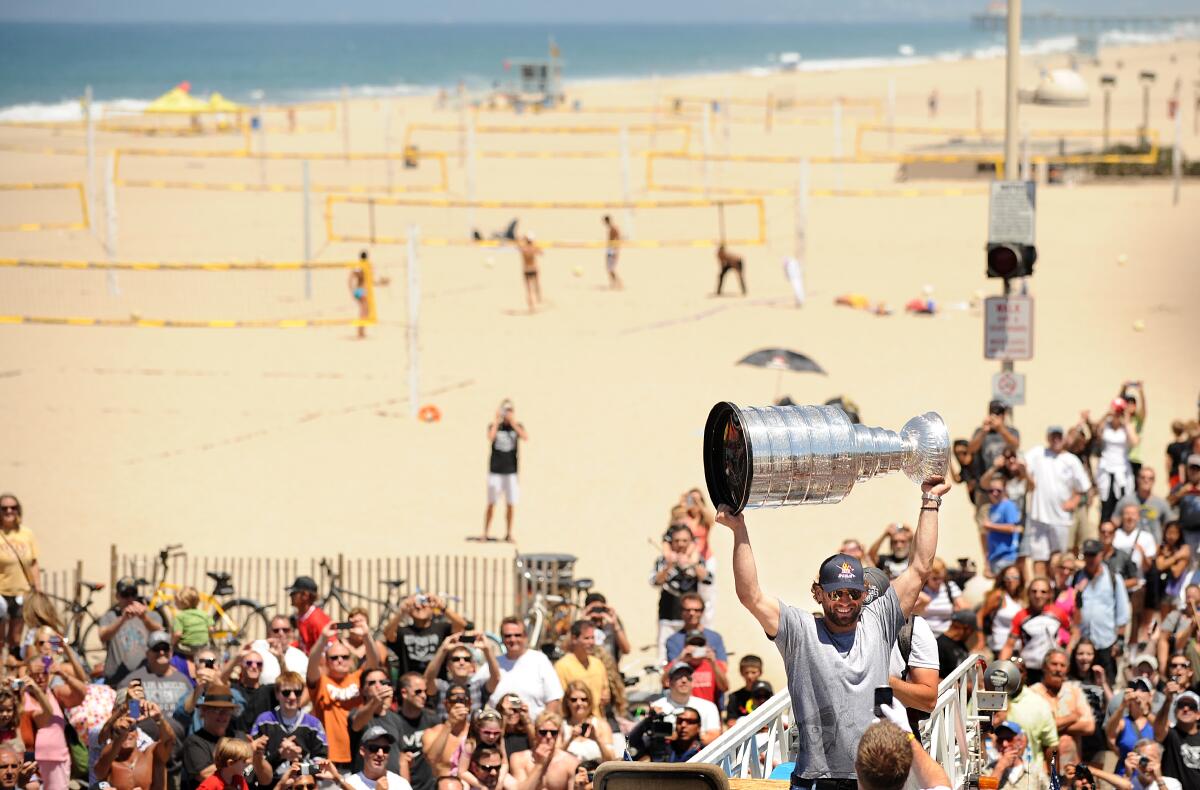Kings are as synonymous with South Bay as the aviation industry and the beach

- Share via
From a chair in his El Segundo office, Kings and AEG Sports Chief Operating Officer Kelly Cheeseman excitedly read an email from his phone.
The message had come from Boeing Historical Services, the latest archival anecdote dug up during his recent deep-dive on the history of the South Bay, the collection of beachside neighborhoods from El Segundo to Torrance that have become the Kings’ de facto home within a home in L.A.
“In 1935,” Cheeseman read aloud, “James H. ‘Dutch’ Kindelberger, President of North American Aviation, Inc. moved machinery and 75 employees from Dundalk, Md., to a 20-acre facility in Inglewood, CA near the edge of Mines Field (now LAX).”
With it, the South Bay’s decades-long relationship with the aviation industry took off, a field of work that employed a generation of families from the area.
“I worked for Hughes [Aviation] for six years before I even worked here,” the Kings’ vice president of marketing, communications, and content, Mike Altieri, said. “We made radars for fighter planes.”
Adrian Kempe scores in overtime and Jonathan Quick makes 32 saves in a 2-1 victory over the New Jersey Devils.
Indeed, aviation might be one of the only things more recognizable around the South Bay than the Kings themselves, who moved their practice facility to El Segundo in 2000 and whose players have long made the community their home base in the vast L.A. market.
“There’s no secret that we have a strong connection to the South Bay,” Cheeseman said. “Our players have literally played in the South Bay for 52 years. The original team, when they flew here, a lot of them settled in Torrance. They eventually evolved and moved over to Manhattan Beach. They’ve just lived in this community and been a part of this community.”
Thus, when the team began the process of designing their Stadium Series uniforms for their outdoor game at the Air Force Academy against the Colorado Avalanche on Feb. 15 — a kit they will reprise for Saturday’s game against the New Jersey Devils at Staples Center — they didn’t have to think hard to come up with aviation-themed inspiration.

“It was trying to build a story line to honor those people,” Cheeseman said.
The P-51 Mustang — “the plane that changed the war and won World War II,” Cheeseman pointed out — was the South Bay-produced plane that served as the core theme of its Stadium Series jerseys, a black-and-white uniform topped with an eye-catching chrome helmet meant to mimic the nose of the plane.
But really, any aircraft that was made by the area’s big three aviation manufacturers — North American Aviation (which created the P-51 before later merging with Rockwell International and then Boeing), Northrop Grumman and Hughes — would have created a similar effect, combining the South Bay’s most intertwined industry with its most integrated sports team.
“The whole goal was, there’s an extreme history tied back to the impact of the aviation industry on Southern California, in particular the South Bay,” Cheeseman said. “Those were the Kings fans. Those grandmothers, grandfathers, dads, kids, those are who became Kings fans. They had an impact on that.”
Torrance native Randy Elkins came from one of those South Bay aviation families. As a kid, while his dad was away at work as a purchaser for Hughes in the 1960s, Elkins and his friends would ride their bikes up Prairie Avenue and watch the then-under-construction Forum be built.

In 1967, when Elkins was 13, the Kings moved into the building as an expansion franchise. He and his dad started going to games, and on increasingly frequent occasions saw the newly arrived hockey players around town.
“They always had, even in the early days, players live in Redondo and Torrance,” Elkins said. “Because the Forum was fairly close.”
In 1973, Elkins got Kings season tickets of his own. Like so many other original South Bay residents (Elkins lives in Ventura County now), he became a fan for life.
“Eventually,” he laughed, “I got to know every nook and cranny of the Forum.”
The Kings’ presence in the South Bay community has only been cemented since. In the 1990s, former Kings captain and current general manager Rob Blake earned the nickname “Mayor of Manhattan Beach” after he built a home in the area and began appearing constantly at the town’s beach volleyball courts.
When the team won its second Stanley Cup title in 2014, it held two parades: a formal procession through the streets of downtown L.A., and another celebratory cavalcade that passed through Redondo Beach, Hermosa Beach and Manhattan Beach that turned out thousands.

Former player and current Kings President Luc Robitaille even appeared in a recent El Segundo Police Department recruitment video. And almost all of the Kings’ current players live a short drive away from their practice rink.
“They’re just a part of the fabric of the community,” Cheeseman said. “I feel like every person I’ve met in the South Bay has gone to school with one of Dustin [Brown’s] kids.”
First-year coach Todd McLellan is one of the newest members of what he calls, “the bubble.”
“I get it now,” McLellan said. “Basically all our hockey people live in the bubble.”
It’s a decades-long connection — reflected most recently in the shiny chrome helmets that will make their first Staples Center appearance Saturday — with a certain part of town that doesn’t seem likely to end any time soon, a specific symbiotic situation between a team and its community not often found in sports.
“The Lakers and Dodgers obviously have this vast brand that reaches everybody,” Cheeseman said. “When you’re different like us, you have to own one thing and then build.”
More to Read
Go beyond the scoreboard
Get the latest on L.A.'s teams in the daily Sports Report newsletter.
You may occasionally receive promotional content from the Los Angeles Times.








